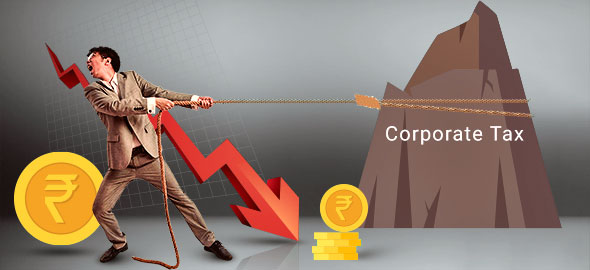Can Tax Cuts Revive the Indian Economy in 2020?

The Indian economy dipped close to 6-year lows in the July-September quarter, touching 4.5%. In fact, following a glorious run in 2018, the economy struggled through 2019, with the three key drivers of economic growth, investment, consumption and exports, declining. Both consumer sentiment and business confidence have slumped through 2019, while the GDP has been on a downward trajectory. Unfortunately, preliminary data for October-November isn’t encouraging, with industrial output and exports shrinking.
“India is now in the midst of a significant economic slowdown,” said Ranil Salgado, Mission Chief for India for the IMF. “Addressing the current downturn and returning India to a high growth path requires urgent policy action,” Salgado stressed.
So, what would help curb this economic slowdown? The efforts at privatization haven’t had the results the government hoped for. There is one thing that has proven to give economy a boost -cutting taxes, both individual income tax and corporate tax.
A Half-Hearted Effort at Corporate Tax Cut
Finance Minister Nirmala Sitharaman introduced a bill in the Lok Sabha in the latter half of November, seeking corporate tax cuts. She proposed that the current 30% corporate tax rate, which is among the highest in the world, to be cut to 22% for existing companies. For new manufacturing companies, incorporated after October 1, 2019, and launching operations before March 31, 2023, Ms. Sitharaman proposed a cut from the current 25% to 15%.
Even if such tax relief is implemented, when we include cess and surcharge, the effective rate for existing companies would be a staggering 25.17%. Compare this to the corporate tax rate in other Asian economies – Hong Kong’s corporate tax rate is 16.5%, Singapore at 17% and even Cambodia is at 20%. So, even after the tax cut, India would continue to have a corporate tax rate that is among the highest.
What About Personal Income Tax?
Following the proposal of a corporate tax cut, expectations for a cut in personal income tax have arisen. Despite the changes proposed in the Union Budget 2019, the individual income tax rate in India remains amongst the highest in the world. This is especially true for the higher tax slabs. While those earning between ₹5-₹10 lakhs per annum are subject to a 20% tax rate, those earning above ₹10 lakhs jump to the 30% bracket. This rate rises to 37% if net income exceeds ₹5 crores per annum. Add the surcharge and the rate jumps to 39%.
Tax relief across the slabs tends to increase disposable income, which then motivates both individuals and businesses to spend and invest. That’s not all.
Impact of Tax Cuts on the Economy
When the economy slumps, government policy needs to focus on increasing spending. When the individual tax rate is cut, there is more money within the household. In fact, personal consumption drives almost 70% of the economy and is a major contributor to the GDP. So, with a lesser amount of the wages going into taxes, families have more to spend.
The same is true for businesses. When business cash flow increases, companies expand activities. They look at hiring, investing and paying dividends. Tax cuts are especially beneficial for small businesses and startups, which account of almost 65% of all new jobs created in the nation.
However, the key is to understand how much of a cut in the effective tax rate would actually fuel the economy. Also, it is important to remember that tax cuts can only be a short-term measure. They tend to increase the government deficit in the long run. Then there is the problem that once a tax cut is put in place, it is extremely difficult to raise taxes once again.
Looking at 2020
While an economic slowdown appears to be a global phenomenon at present, there is no denying that some urgent measures are required to stem the slump. Some measures have already been put in place, which raises hopes that 2020 might fare better than 2019. Further relief measures, such as easing of labor regulations or counter-cyclical stimulus in the upcoming budget, along with sector-specific initiatives could have a cumulative impact. There also are expectations that the liquidity and financing situation for stressed NBFC sector would also improve as the year progresses.
Analysts expect the Union Budget for 2020-21 to target GDP growth of 6%-6.5%. The RBI expects an early recovery, predicting average growth of 6.1% for April-September 2020. Most forecasts for the Indian economy have been cut to some extent, including the estimates released by the IMF and World Bank. However, the predicted growth rates are still optimistic, at above the 6% level. Will the government measures be enough to drive such growth? Only time will tell.
 Rakesh Wadhwa. Ever since, I was a school boy, I knew India was on the wrong path. Socialism was just not what we needed to get ahead. Government controlled our travel; government controlled our ability to buy and sell; and government controlled our freedom to move our money. My life has focused on the inherent rights people have. When I was in college, I never understood, what the governments meant by their "socialistic attitude". If people are free to buy, sell and move their capital themselves without any restrictions by state, then the welfare of people is inevitable & hence the countries they live in will become wealthy. The government has no right whatsoever, to point a finger at me or my business. I am not a revolutionary. I just want to light up my cigarette and not get nagged about it. I believe in non-interfering attitude to attain more.
Rakesh Wadhwa. Ever since, I was a school boy, I knew India was on the wrong path. Socialism was just not what we needed to get ahead. Government controlled our travel; government controlled our ability to buy and sell; and government controlled our freedom to move our money. My life has focused on the inherent rights people have. When I was in college, I never understood, what the governments meant by their "socialistic attitude". If people are free to buy, sell and move their capital themselves without any restrictions by state, then the welfare of people is inevitable & hence the countries they live in will become wealthy. The government has no right whatsoever, to point a finger at me or my business. I am not a revolutionary. I just want to light up my cigarette and not get nagged about it. I believe in non-interfering attitude to attain more. 
 The Bastiat Award is a journalism award, given annually by the International Policy Network, London. Bastiat Prize entries are judged on intellectual content, the persuasiveness of the language used and the type of publication in which they appear. Rakesh Wadhwa won the 3rd prize (a cash award of $1,000 and a candlestick), in 2006.
The Bastiat Award is a journalism award, given annually by the International Policy Network, London. Bastiat Prize entries are judged on intellectual content, the persuasiveness of the language used and the type of publication in which they appear. Rakesh Wadhwa won the 3rd prize (a cash award of $1,000 and a candlestick), in 2006.
What the readers are saying…